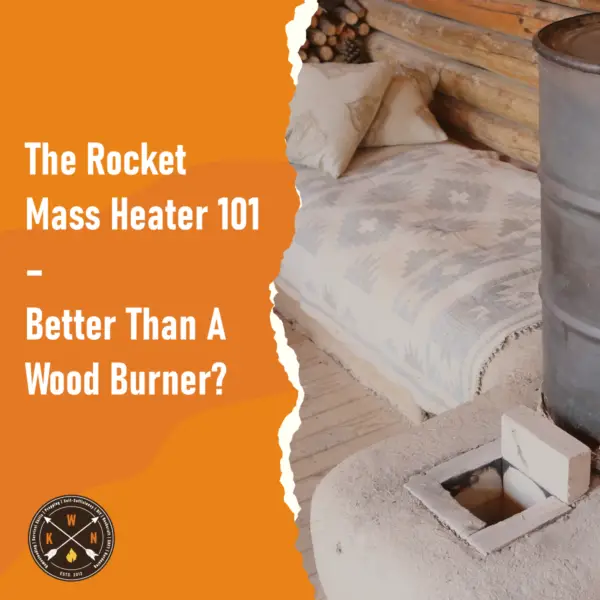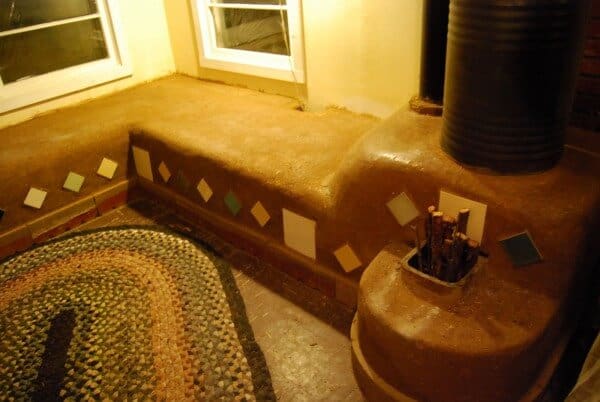
Looking for the most efficient way of heating your home? Perhaps you’ve heard all about rocket mass heaters and just how clean they are? Whatever the reason, this guide takes a closer look at these heaters, explains how to build them, and covers all of their benefits (of which there are many!).
Table of Contents
ToggleWait A Minute… Just What Are Rocket Mass Heaters?
You’re likely here because you know all about rocket stove mass heaters and the benefits that they provide. However, for those who may be less than completely up on everything that these handy heaters can offer, here’s a quick summary.
Rocket mass heaters can:
- Heat up your log cabin or home with 80% to 90% less wood than is required with a traditional fire or log burning stove.
- Exhausted output is practically all steam and CO2 (this is minus a little smoke at the beginning).
- The heat from a single rocket mass fire can burn and heat your home for days on end.
- A rocket stove mass heater can be easily built within the space of one or two days (less if you have a helping hand from friends or family).
- When being particularly careful, you can build a rocket mass heater for under $20!
What Are People Saying?
Rocket stove mass heaters have a great reputation amongst the survivalists and off the grid living crowd. Here are some of the most common comments that you’ve likely heard:
“I burn nothing but dead branches, and the heating within my home has never been warmer”.
“They burn cleaner than any other form of heating… and are a lot more efficient to boot”.
“I’m a city dweller who uses rocket mass heating to cut down my bills”.
So, now that we know that these really are the most efficient forms of heating on the planet, let’s get down to the nitty-gritty of how they work, and what you’ll need to build one.
 Rustic rocket mass heater used to heat a permanent tipi
Rustic rocket mass heater used to heat a permanent tipi
The science behind rocket mass heaters
OK, so you may be wondering just how rocket stove mass heaters work, particularly as they seem to buck all the trends and go against all of the fire guidance that you’ve ever been taught (e.g. they output no smoke and the wood burns sideways).
What’s more, with a 75% efficiency rate you’d think that the most wood you could possibly save on would be the remaining 25%, right? And to top it all off, just how on earth can such a contraption not emit a plume of smoke, given that there’s a gaping big hole right in the top of it?
Well, many of these questions are answered as soon as you see a rocket mass heater in action, here’s a quick overview…
How rocket mass heaters work – In detail
With the sticks within a rocket mass heater stood straight up, it’s only the bottom ends that burn and, what’s more, as they are at a junction within the heater, they burn sideways. The heat within is also insulated, which is why rocket mass heaters get so hot. This naturally has a strong convective current, encouraging hot gasses to hit the barrel where they then expel much of their heat, consequentially cooling the gasses and making them easier to push around the heater. The gasses that finally exit are then simply made up of steam and carbon dioxide.
The main magical act that makes a rocket mass heater super special, and the main working of the rocket mass heater that we should be in awe of, is found within the heat riser. Here this open-ended combustion chamber, coupled with a strong convective current, ensures that the smoke never gets sucked upwards and instead the air is continuously sucked in from the wood-filled hole, meaning that no smoke escapes at all. In fact, it’s so hot within this top region that most of the smoke gets burned up!
How to build a rocket mass heater
2 Rocket mass heater plans from the tried, tested and completely trusted experts
 The ‘Bonny Convection Bench’ rocket mass heater
The ‘Bonny Convection Bench’ rocket mass heater
The first tutorial is based upon one of the most popularly referred to designs for rocket mass heaters there are. Constructed by Ernie and Erica Wisner, this is a roadmap that has been carefully put together by two engineering veterans (who reassuringly have over 700 rocket mass heater builds under their belt).
Here’s the link for the ‘Bonny Convection Bench’ rocket mass heater professional build plans (link currently broken). It currently costs $25 but they are professional quality build plans that could save you $1000s
 ‘RocketMassHeater-Annex6’ rocket mass heater
‘RocketMassHeater-Annex6’ rocket mass heater
Need a pretty large rocket mass heater for your home? Well, the second tutorial below are for a heater that’s more than capable of heating a 3 storey, multi-level family home, even in cooler regions such as right by the coast. The reinforcement within the plans along with the in-built air flow channels ensure that any flooring, hardwood or otherwise, is completely protected whilst providing for effective circulation that heats the whole house.
Here’s the link for the ‘RocketMassHeater-Annex6’ rocket mass heater professional build plans (Link currently broken). It currently cost $25 but they are professional quality build plans that could save you $1000s
If you need an adapted plan to fit within your cabin then here it is. This design maps out an eight inch diameter rocket mass heater which takes up just 3.5 foot by 9 foot on the floor.
Rocket mass heaters versus the traditional wooden stove
There may be many readers out there who are avid fans of the conventional wooden stove, and who may be seriously pessimistic about just what a rocket mass heater may be able to offer them. So this section is dedicated to demonstrating just how a rocket mass heater compares when talking about heating efficiencies between the two.
“They say that a current wood stove is 75% efficient… so if the most improvement that can be seen is 25%, and rocket mass heaters can heat the home with a tenth of the wood… isn’t a rocket mass heater then 750% efficient? And why wouldn’t 100% be the maximum efficiency rate at which you can operate?”
The statement above sets out both a confusing landscape as well as a few common misunderstandings. And there are two ways in which this conundrum can be answered.
First, you should measure the temperature and volume of smoke that leaves your traditional wood stove (in short, it’s both extremely hot and of a large amount) and compare this to the exhaust found within a rocket mass heater (where there is a trickle of output that has a temperature of a little more than room temperature). This shows that there is far more heat that is retained by the rocket mass heater than by the conventional stove.
Second, we should look at the figures. Being 75% efficient does not consider the heat that escapes up through the chimney in smoke form. If we were to test a conventional oven within the lab we’d find that between 14% and 16% of the heat were escaping in smoke form alone. So then the 75% rating then becomes 64%. The higher rating is simply a marketing spiel helping the big stove companies in their quarterly figures.
Lastly, we must consider that this original 75% may not be all that it seems in any event. This is a rating that was found within a laboratory with experts who were focused on getting the very best rating (and therefore skewing the results). So even though a wood stove may be able to achieve 75% when in ideal laboratory settings with a bunch of experts, the rating that you’ll receive within your home is likely to be far less. In fact, it’s been found that on average the operating efficacy of a conventional wood-burning stove tends to level off at around 35%, which becomes ever less efficient for those who are opting to burn damp leaves (where efficiency can run at something like 5%!). Now in comparison, we take rocket mass heaters, which have no way of losing their inner airflow, and thus never lead to a slow, inefficient burn.
If you liked this post, but you’d like something a bit simpler to build first, why not check out our DIY rocket stove post?




